In this article, we will discuss the primary elements for pressure measurement. Pressure measurement is the most important activity everywhere. When solid or liquid or gas experience a force it causes displacement. As a result, the physical movement caused by the force shows the variation in the pressure.
The calibrated pointer shows the variation in the pressure. It is also possible to generate measurable outputs in electrical forms, such as resistance and capacitance changes proportional to the pressure.
The primary elements of pressure measurement detect the pressure. The Bourdon tubes, bellows, diaphragms, and capsules are the commonly used primary elements of pressure measurement.
Now, we will discuss the primary elements in detail.
1. Bourdon Tubes
Bourdon tubes are the most common type of primary pressure sensing element. The bourdon tube is either available in C-shaped or spiral or helix with an oval cross-section. When the pressure exerting liquid or gas enters the tube, the elliptical cross-section tends to change into a circular form. This causes more opening of the C shape and in the case of the helix, the helix extends more.
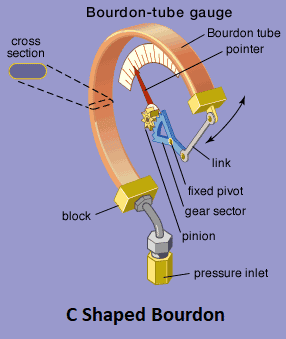
The closed end of the tube has its attachment to the geared mechanism, which causes the pointer hand to bend due to displacement. The deflection on the calibrated pointer scale represents the pressure exerted by the medium. It is also possible to get the output in the form of an electrical signal by connecting its mechanism to a potentiometer.
The bourdon tubes are available in different shapes and sizes. There are the following types of bourdon tubes.
- C-shaped Bourdon Tube
- Helical Borden Tube
- Spiral Type bourdon tube
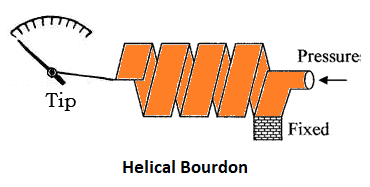
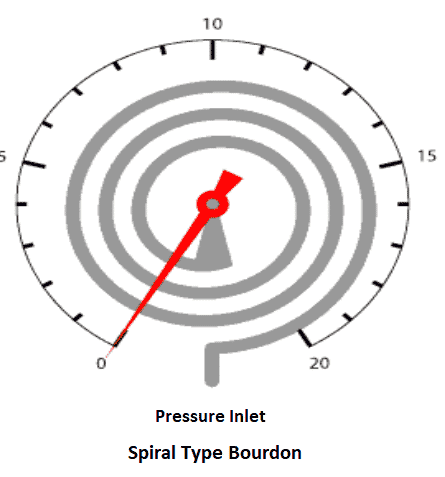
Pros & cons of bourdon tubes
The bourdon tubes are cost-effective and simple in construction. The disadvantage of these bourdon tubes is that the zero drifts frequently due to changes in the shape of the tube. Also, linearity changes with the aging effect. If bourdon tubes are in hazardous service, then draining bourdon tubes for removing them becomes a very difficult task.
Material of bourdon tubes
Depending on the application requirements such as corrosion resistance, cost, size, gauge range, pressure resistance, and burst pressure, the tube can be made of metal such as copper, aluminum, brass, or nickel alloy such as Monel.
What is the measuring range of bourdon tubes?
The C-type bourdon tube is most suitable for measuring pressure up to 60 bar. For higher pressure measurement, spiral or helical Bourdon tubes are suitable.
2. Bellows
A bellows detection element is simply a container that expands according to the force applied by the pressure medium contained inside.
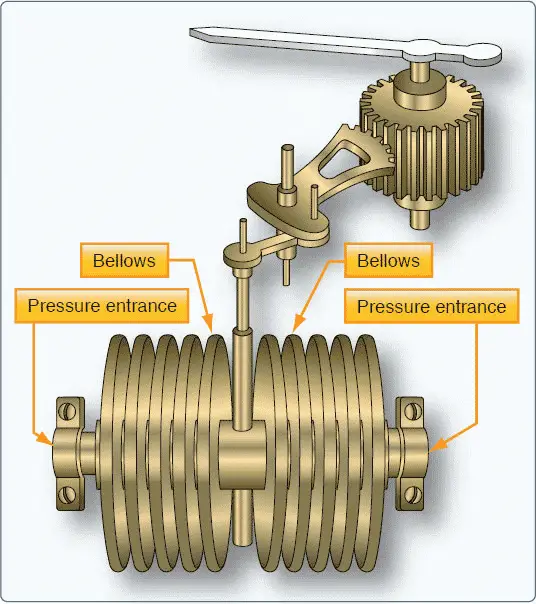
Bellows can be machined from bars, rolled from tubes, or manufactured in a series of welded annular rings. Internally mounted or external springs are used to improve the bellow’s response to changes in positive and negative pressures. Therefore, the deflection property is a combination of the mechanical properties of the bellows and the mechanical properties of the spring.
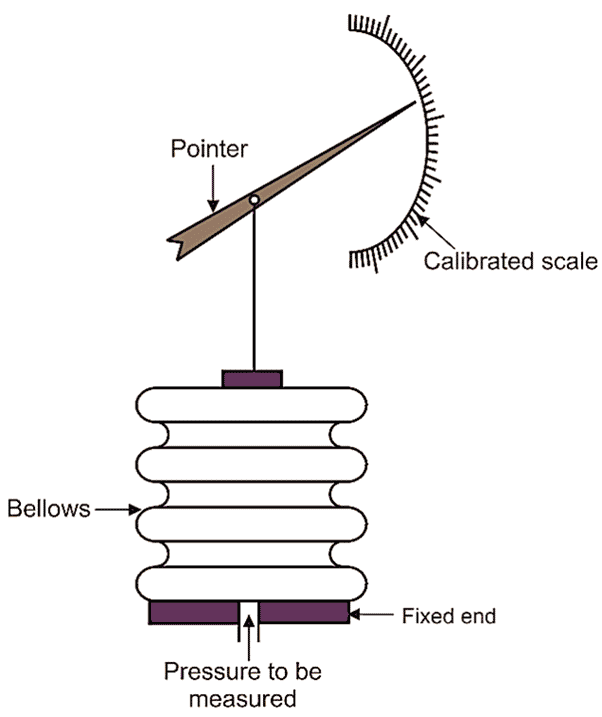
An attached mechanical gear mechanism converts the expansion as well as the contraction of the bellows due to changing pressure of liquid or gas into a proportional deflection of the pointer which indicates the pressure on a scale that is calibrated.
The bellows is quite similar to the Bourdon tube. Alternatively, for getting output in electrical quantity the mechanism has its attachment to a potentiometer. The bellows are most suitable for measuring high pressures. Similar to bourdon tube, if bellow is used in hazardous service, then draining bellow for removing it becomes a very difficult task.
What are bellows made up of?
Bellows are usually made of metals such as phosphor bronze, beryllium copper, brass, and stainless steel.
What is the measuring range of bellows?
Differential pressure up to 70 bar or static pressure up to 750 bar can be measured using bellows.
3. Diaphragms
A diaphragm is simply a plate on which one side the pressure of the liquid or gas is applied while another side is the reference. The reference can be a sealed chamber or kept open to atmospheric or given pressure through other liquid or gas for differential pressure measurement.
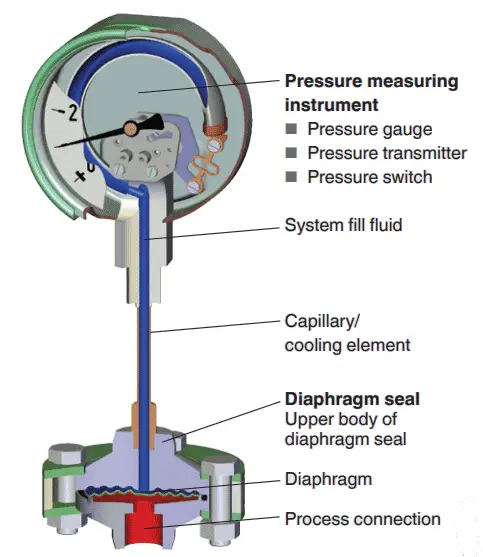
The diaphragm is generally filled with oil which is incompressible. Due to an increase or decrease in pressure, the diaphragm deflects on either side proportional to the amount or say magnitude of the pressure applied. This movement is used to create change in output in electrical form i.e. either capacitance or resistance.
The diaphragms are generally used in pressure transmitters. As the pressure changes, the diaphragm also moves to cause the change in distance between the reference plate and the diaphragm. This creates a change in capacitance which is calibrated to show pressure. The reference plate can be another diaphragm too which can give differential pressure readings.
The most important advantage of this diaphragm is that the deformation o doesn’t occur as seen in bourdon and bellows. Hence drifting and linearity change is not a major issue here.
What are diaphragms made up of?
The diaphragm can be made of metal or ceramic. Metal diaphragms are often made up of stainless steel or titanium, making them compatible with a variety of pressure media. These diaphragms can withstand a wide range of applied pressures. Ceramic diaphragms offer a wide range of compatibility with different types of materials. Ceramic diaphragms are also having excellent corrosion resistance.
Another type of diaphragm called slack diaphragm is used to measure very small pressures. Diaphragm materials are usually synthetic inelastic materials such as polyethylene or natural materials such as silk. Due to the non-elastic nature of the material, an external spring is required to counteract the diaphragm, allowing calibration and ensuring accurate operation.
What is the measuring range of the diaphragm?
The diaphragm measures pressure between 10 mbar and 40 bar.
4. Capsules
Capsules are also a form of a diaphragm. A capsule consists of two or more diaphragms welded at the ends for sensing the pressure.
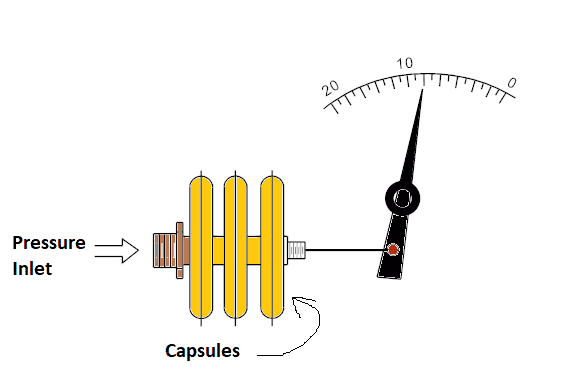
Capsules sense relatively low pressure as compared to diaphragms. Capsules can be used in single or in groups (piling capsules one upon another) to increase the sensitivity as well as mechanical strength. The main advantage of the capsule is its small size, simple structure, and low-pressure measurement as compared to the diaphragm. Capsules cannot be used for liquids because the liquid once filled in the capsule cannot be drained. This may cause errors in readings. Hence capsules are used for measuring low-pressure gases only.
What are capsules made up of?
Capsules are generally made up of phosphor bronze and stainless steel.
What is the measuring range of capsules?
Capsule pressure gauges are suitable for measuring very low negative and positive pressures ranging from 0 – 0.5 mbar to 0-1000 mbar.